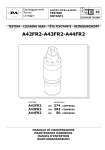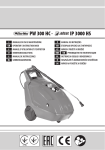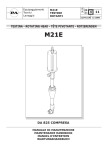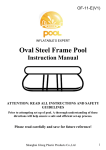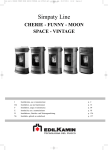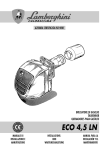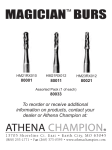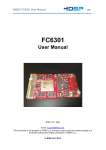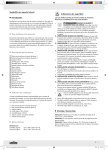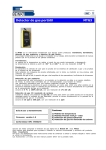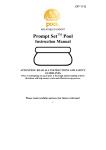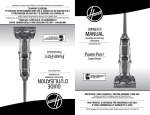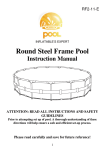Download Tête MI63 - MI85
Transcript
Equipaggiamenti Tecnici Lavaggio MI63-MI63A-MI85 TESTINEROTANTI I F GB D 4 06 12.9406.90 06-2006 TESTINA - CLEANING HEAD - TÊTE PIVOTANTE - REINIGUNGSKOPF MI63-MI63A-MI85 MANUALE DI MANUTENZIONE MAINTENANCE BOOKLET MANUEL D’ENTRETIEN WARTUNGSHANDBUCH 1 Indice l l l l Avvertenze Indicazioni generali Smontaggio/Verifica Montaggio/Manutenzione pag. 2 pag. 2 pag. 6 pag. 20 Avvertenze l Le operazioni descritte nel presente manuale devono essere eseguite esclusivamente da personale qualificato. l Per la manutenzione programmata vedere Manuale d’istruzione alla voce Manutenzione. Indicazioni generali l Per lo smontaggio e il rimontaggio dei seeger fare attenzione a non forzare troppo l’apertura per evitare che perdano la loro forma originaria. Se possibile si consiglia di utilizzare una pinza con finecorsa. l La Testina STANDARD è fornita di guarnizioni (DINAMICHE) in PTFE + O-Ring in EPDM. Lubrificare esclusivamente con GRASSO SILICONICO codice: 14.6552.00 . Per l’utilizzo di liquidi detrgenti, additivi chimici ecc. non compatibili con le guarnizioni standard è indispensabile contattare il nostro UFFICIO TECNICO. A richiesta le guarnizioni (DINAMICHE) O-RING sono disponibili anche in diverso materiale, NBR-FFKM(kalrez)-FKM(viton). Le guarnizioni (STATICHE) sono in FKM (viton). l Durante lo smontaggio verificare sempre l’integrità e il buono stato di guarnizioni, cuscinetti e ingranaggi. Se un elemento non è perfettamente integro e funzionante chiederne il ricambio al costruttore. l Durante il montaggio ingrassare sempre i riporti ceramici e le guarnizioni di tenuta, utilizzando grasso siliconico codice: 14.6552.00 . Simbologia utilizzata @ Indica una procedura per il montaggio/smontaggio. I Indica un’operazione di verifica/manutenzione su alcune parti. M Indica accorgimenti/procedure cui prestare particolare attenzione 2 Table of contents l l l l Warnings General indications Disassembly/Checking Assembly/Maintenance page 3 page 3 page 6 page 20 Warnings l Only qualified personnel should carry out the operations described in this manual. l For programmed maintenance check the instruction book under the heading “maintenance”. General indications l For disassembling and reassembling the snap rings (seeger) be careful not to force the opening too much so that they do not lose their original shape. We advise using pliers with end stop, if possible. l The STANDARD Tank cleaning head is supplied with seals (DYNAMIC) in PTFE + O-Ring in EPDM. Lubricate ONLY with SILICONE GREASE P/N: 14.6552.00. For use with detergent liquids, Chemical additives etc. that are not compatible with standard seals, it is essential to contact our TECHNICAL OFFICE for further information. On request, the O-RING seals (DYNAMIC) are available in different materials such as NBR-FFKM(kalrez)-FKM(viton). The STATIC seals are in FKM (viton). For programmed maintenance check the instruction book under the heading “maintenance”. l When disassembling check that the gaskets, bearings and gears are intact and in good condition. If an element is not perfectly intact and if it does not work properly, please ask for a spare from the manufacturer. l Always grease the ceramic coatings and the seal gaskets with silicon grease P/N: 14.6552.00 while assembling. Used symbols @ Indicates an assembling/disassembling procedure. I Indicates a checking/maintenance operation on several parts. M Indicates suggestions/procedures to which particular attention should be paid. 3 Table des matières l l l l Avertissements Indications générales Démontage/Vérification Montage/Entretien page 4 page 4 page 6 page 20 Avertissements l Les opérations décrites dans ce Manuel ne doivent être exécutées que par un spécialiste. l Pour l’entretien programmé voyez le Manuel d’usage et entretien sous la voix Entretien. Indications générales l Pour le démontage et le remontage des circlips, ne pas trop forcer l’ouverture afin d’éviter qu’ils perdent leur forme originale. Si possible, nous conseillons d’utiliser une pince avec fin de course. l La tête de lavage STANDARD est douée de joints (DYNAMIQUES) en PTFE + EDPM. Lubrifiez exclusivement avec de la GRAISSE SILICONE référence: 14.6552.00 . Pour l’utilisation de liquides dètergents, additifs chimiques etc. non compatibles avec les joints standard il est indispensable de contacter notre SERVICE TECHNIQUE. Sur demande les JOINTS TORIQUES (DYNAMIQUES) sont disponibles en d’autres matériels , à savoir : NBR, KALREZ, VITON. Les joints (STATIQUES) sont en FKM (VITON). l Pendant le démontage, vérifier toujours si les garnitures, les roulements et les engrenages sont intacts et en bon état. Si un élément n’est pas parfaitement intact et en bon état de marche, demander une pièce de rechange au fabricant. l Pendant le montage, graisser toujours les rechargements céramiques et les joints d’étanchéité, en utilisant de la graisse silicone référence: 14.6552.00 . Symboles utilisés @ Indique une procédure de montage/démontage. I Indique une opération de contrôle/entretien sur certaines parties. M Indique des précautions/procédures auxquelles il faut faire particulièrement attention. 4 Inhaltsverzeichnis l l l l Hinweise Allgemeine Angaben Ausbau/Überprüfung Einbau/Wartung Seite 5 Seite 5 Seite 6 Seite 20 Hinweise l Die im vorliegenden Handbuch beschriebenen Arbeiten dürfen ausschließlich von qualifiziertem Personal ausgeführt werden. l Für eine programmierte Instandhaltung siehe Bedienungsanleitung. Allgemeine Angaben l Bei Ausbau und beim Wiedereinbau der Sprengringe darauf achten, dass sie nicht zu stark geöffnet werden, damit sie ihre ursprüngliche Form beibehalten. Falls möglich eine Zange mit Anschlag verwenden. l Der STANDARD Tankreiniger hat PFTE + EPDM (DYNAMISCHE) Dichtungen. Ausschliesslich mit SILIKONFETT B/N: 14.6552.00 beschmieren. Bei Benutzung von flüssigen Reiningungsmitteln bzw.mischen Zusatzstoffen usw., die mit STANDARD Dichtungen nicht verträglich sind, ist es notwendig, sich mit unserer technischen Abteilung in Verbindung zu setzten. Nach Aufrage stehen die DYNAMISCHE Dichtungen auch in anderen Materialen wie NBR-KALREZ-VITON zur Verfügung. Die (STATISCHE) Dichtungen sind in FKM (VITON). l Beim Ausbau stets die Unversehrtheit und den einwandfreien Zustand der Dichtungen, der Lager und der Zahnräder überprüfen. Das Ersatzteil beim Hersteller anfordern, falls ein Element nicht vollkommen unversehrt und funktionstauglich ist. l Beim Einbauen immer die Keramikauflage und die Dichtungen mit Silikonfett B/N: 14.6552.00 schmieren. Verwendete Symbole @ Weist auf eine Vorgehensweise für den Ausbau/Einbau hin. I Weist auf einen Vorgang für die Überprüfung/Wartung einiger Bauteile hin. M Weist auf Maßnahmen/Vorgehensweisen hin, die in besonderer Weise beachtet werden müssen. 5 Smontaggio/Verifica Disassembly/Checking DEUTSCH FRANÇAIS ENGLISH ITALIANO 1 2 M Prima di iniziare le operazioni di smontaggio si raccomanda di allestire una morsa con protezioni in alluminio, in modo da non danneggiare la testina. @ Sistemare la testina su una morsa come indicato in fig.1. Togliere svitando le due manopole e svitare la giunzione con una chiave a forcella di 46 mm. @ Estraendo la giunzione si può accedere all’anello OR di tenuta e al filtro (fig.2). I Verificare l’integrità dell’anello di tenuta. Nel caso sia da sostituire è possibile ordinare sia il singolo anello che la serie completa di guarnizioni. I Verificare l’integrità e la pulizia del filtro. M We advise setting up a vice with aluminum protections before starting the disassembling operations so as not to damage the head. @ Position the head on a vice as shown in fig.1. Unscrew the two knobs to remove them and unscrew the joint with a 46 mm. fork wrench. @ The O-ring and the filter can be reached by removing the joint (fig.2). I Check that the grommet is intact. If it has to be replaced, either the single ring or the complete series of gaskets can be ordered. I Check that the filter is clean and that it is intact. M Avant de commencer les opérations de démontage, nous recommendons de préparer un étau avec des protections en aluminium, de manière à ne pas endommager la tête. @ Positionner la tête dans un étau comme montré a la fig.1. Enlever les deux boutons en les dévissant et dévisser le joint à l’aide d’une clef à fourche de 46 mm. @ En extrayant le joint, on peut accéder à la bague d’étanchéité et au filtre (fig.2). I Vérifier l’intégrité de la bague d’étanchéité. Si elle doit être remplacée, il est possible de commander soit uniquement la bague, soit la série complète de garnitures. I Vérifier l’intégrité et la propreté du filtre. M Vor Beginn des Ausbaus sollte der Schraubstock mit Schutzbacken aus Aluminium ausgestattet werden so dass der Kopf nicht beschädigt wird. @ Den Kopf (wie auf Abbildung 1 gezeigt) in einen Schraubstock einspannen. Die beiden Griffe abschrauben und die Dichtung mit einem 46mm Maulschlüssel herausschrauben. @ Durch das Entfernen der Verbindung wird der O-Ring und der Filter zugänglich (Abb.2) I Die Unversehrtheit des Dichtungsrings überprüfen. Falls er ersetzt werden muss, so kann sowohl der einzelne Ring, als auch der vollständige Dichtungssatz bestellt werden. I Die Unversehrtheit des Filters kontrollieren und sicherstellen, dass er sauber ist. 6 Démontage/Vérification Ausbau/Überprüfung 3 @ I I @ I I @ I I I @ I I I Zum Ausbauen des Kollektors die 6 Schrauben mit einem 6 mm Inbusschlüssel lösen. Es kann nützlich sein, den Kollektor leicht zu drehen und mit einem Schraubenzieher zu hebeln, um ihn zu lösen; dabei darauf achten, dass kein Bauteil beschädigt wird (Abb.3). Die Unversehrtheit alle Dichtungen zwischen Kollektor und Stator überprüfen. An diesem Punkt ist der Läufer sichtbar. Zum Herausnehmen eine Zange wie auf Abb. 4 verwenden. Die Unversehrtheit der Rippen des Läufers und die Abnutzung der Keramikauflage seines zentralen Bolzens überprüfen. Die Unversehrtheit und die Abnutzung des Belags unter dem Läufer kontrollieren. Insbesondere dürfen die oberen Zähne nicht zu stark abgenutzt sein. Die Unversehrtheit und die Abnutzung der Buchsen (Abb.5) des Kollektors und des Stators überprüfen. Ausbauen und ersetzen, falls die Zähne abgenutzt sind. 7 DEUTSCH I @ Pour démonter le collecteur, dévisser les 6 vis à l’aide d’une clef six-pans mâle de 6 mm. Il peut être utile de tourner légèrement le collecteur et de se servir d’un tournevis plat comme d’un levier et de l’extraire en faisant attention à n’endommager aucun composant (fig.3). Vérifier l’intégrité de toutes les garnitures placées entre le collecteur et le stator. La roue à ailettes est maintenant visible. Pour l’extraire, utiliser une pince comme le montre la fig.4. Vérifier l’intégrité des ailettes de la roue et l’usure des rechargements céramiques de son axe central. Vérifier l’intégrité et l’usure de la plaquette placée sous la roue. En particulier, les dents supérieures ne doivent pas être trop usées. Vérifier l’intégrité et l’usure des douilles (fig.5) du collecteur et du stator. Si les dents sont usées, procéder à l’extraction et à la substitution. FRANÇAIS I @ To disassemble the manifold unscrew the 6 screws using a 6 mm. hexagonal male wrench. It may be useful to slightly rotate the manifold and use a flat screwdriver as a lever to extract it, making sure that no component is damaged (fig.3). Check that all the gaskets between the manifold and the stator are intact. At this point the rotor can be seen. Use pliers to extract it as shown in fig.4. Check the wear on the ceramic coatings of the rotor central pivot and that the rotor blades are intact. Check the wear of the pad under the rotor and that it is intact. In particular the upper teeth must not be overworn. Check the wear of the manifold and stator bushings (fig.5) and that they are intact. If the teeth are worn remove and replace them. ENGLISH I @ I Per smontare il collettore svitare le 6 viti servendosi di una chiave esagonale maschio di 6 mm. Può essere utile ruotare leggermente il collettore e servirsi di un cacciavite piatto per fare leva ed estrarlo, facendo attenzione a non danneggiare nessun componente (fig.3). Verificare l’integrità di tutte le guarnizioni poste tra il collettore e lo statore. A questo punto è visibile la girante. Per estrarla utilizzare una pinza come in fig.4. Verificare l’integrità delle alette della girante e l’usura dei riporti in ceramica del suo perno centrale. Verificare l’integrità e l’usura della pasticca posta sotto la girante. In particolare i dentini superiori non devono essere troppo consumati. Verificare l’integrità e l’usura delle boccole (fig.5) del collettore e dello statore. Se i dentini sono usurati procedere all’estrazione e alla sostituzione. ITALIANO I @ I 4 ITALIANO 5 6 @ Smontare gli iniettori svitando il tappo come in fig.6, ed eventualmente spingendo dall’interno dello statore con un utensile. I Verificare l’integrità degli iniettori e dei relativi anelli di tenuta. M Gli iniettori esistono di diverse misure, a seconda dell’utilizzo della testina. Accertarsi di sostituirli con altri della stessa misura, e che siano adeguati alla portata dell’acqua a cui la testina è collegata. @ Togliere lo statore tirandolo verso l’alto come in fig.7. Se necessario aiutarsi ruotandolo ed eventualmente facendo leva con un cacciavite piatto. I Verificare l’integrità dell’anello di tenuta posto alla base dello statore. Disassemble the injectors by unscrewing the cap as shown in fig.6 and if necessary pushing from inside the stator with a tool. I Check that the injectors and the relative grommets are intact. M There are various sized injectors, according to the use of the head. Make sure that they are replaced with those of the correct size and that they are adjusted to the water flow rate the head is connected to. @ Remove the stator by pulling it upwards as shown in fig.7. If necessary help by rotating it and levering it with a flat screwdriver. I Check that the grommet at the base of the stator is intact. ENGLISH @ Démonter les injecteurs en dévissant le bouchon comme le montre la fig.6, et éventuellement en poussant de l’intérieur du stator avec un outil. I Vérifier l’intégrité des injecteurs et des joints d’étanchéité correspondants. M Les injecteurs existent de plusieurs mesures, suivant l’utilisation de la tête. Veiller à les remplacer par d’autres de la même mesure, et qui soient adaptés au débit d’eau auquel elle est reliée. @ Enlever le stator en le tirant vers le haut comme le montre la fig.7. Si besoin est, s’aider en le tournant et éventuellement en se servant d’un tournevis plat comme levier. I Vérifier l’intégrité du joint d’étanchéité placé à la base du stator. FRANÇAIS @ Den Stopfen abschrauben wie auf Abb. 6 gezeigt, und die Einspritzer ausbauen, und gegebenenfalls den Stator mit einem Werkzeug nach innen schieben. I Die Unversehrtheit der Einspritzer und der entsprechenden Dichtungsringe überprüfen. M Die Einspritzer sind in Abhängigkeit von der Verwendung des Kopfes in verschiedenen Größen vorhanden. Sicherstellen, dass sie durch solche von der gleichen Größe ersetzt werden, und dass sie für den angeschlossenen Wasserdurchsatz geeignet sind. @ Den Stator nach oben herausziehen, wie auf Abb. 7 gezeigt. Falls erforderlich drehen und mit einem flachen Schraubenzieher hebeln. I Die Unversehrtheit des Dichtungsrings an der Basis des Stators überprüfen. DEUTSCH @ 8 B 8 7 A questo punto risultano visibili i satelliti superiori. Per estrarli servirsi di una pinza come in fig.8, facendo attenzione a non danneggiare i denti. I satelliti sono disposti su tre piani col relativo portasatellite. Questa operazione pertanto è da ripetere per ognuno. I Per ogni satellite è necessario verificare: l’usura del diametro interno (accertarsi che non sia eccessivo il gioco una volta montato sul suo perno), l’usura e l’integrità dei denti. I Del portasatellite occorre verificare l’usura dei tre perni superiori e lo stato dei denti nella parte inferiore. I I due portasatelliti superiori sono dotati di una pasticca (A, fig.8) che li distanzia dal portasatellite che sta sotto. Anche questa deve essere verificata. M I satelliti superiori, ruotando a velocità più elevate, sono maggiormente soggetti ad usura. E’ consigliabile quindi effettuare una “rotazione” dei gruppi di satelliti all’atto del montaggio, invertendo primo e l’ultimo gruppo (vedere “montaggio/manutenzione). @ ITALIANO At this point the upper pinions can be seen. To extract them use pliers as shown in fig.8, being careful not to damage the teeth. The pinions are positioned on three levels with relative pinion-carriers. Therefore this operation has to be repeated for each one. I Check the following for each pinion: the wear of the internal diameter (make sure that the slack is not excessive after it has been mounted on its pivot), the wear of the teeth and that they are intact. I Check the wear of the upper three pivots of the pinion-carrier and the state of the teeth in the lower part. I The two upper pinion-carriers are equipped with a pad (A, fig.8) that separates them from the pinion-carrier which is below. This also has to be checked. M The upper pinions, rotating at higher speeds, are subject to greater wear. Therefore we advise carrying out a “rotation” of the pinion groups when assembling, inverting the first and the last group (see “assembling/maintenance). @ ENGLISH Les satellites supérieurs sont maintenant visibles. Pour les extraire, se servir d’une pince comme le montre la fig.8 en veillant à ne pas abîmer les dents. Les satellites sont disposés sur trois étages avec leur porte-satellite. Cette opération doit donc être répétée pour chacun. I Pour chaque satellite, il faut vérifier : l’usure du diamètre interne (s’assurer qu’il n’y a pas de jeu excessif une fois monté sur son axe), l’usure et l’intégrité des dents. I Sur le porte-satellite, il faut vérifier l’usure des trois axes supérieurs et l’état des dents dans la partie inférieure. I Les deux porte-satellites supérieurs sont munis d’une plaquette (A, fig.8) qui les espace du portesatellite qui se trouve dessous. Celle-ci aussi doit être contrôlée. M Les satellites supérieurs, en tournant plus vite, sont davantage sujets à usure. Nous conseillons donc d’effectuer une “rotation” des groupes de satellites au moment du montage, en inversant le premier et le dernier groupe (voir “montage/entretien”). @ I I M und die erste mit der letzten Gruppe zu vertauschen. 9 DEUTSCH I An diesem Punkt sind die oberen Satelliten sichtbar. Zum Herausziehen eine Zange verwenden wie auf Abb. 8 gezeigt und darauf achten, dass die Zähne nicht beschädigt werden. Die Satelliten sind mit der entsprechenden Halterung auf drei Ebenen angeordnet. Dieser Vorgang muss daher für jede Ebene wiederholt werden. Bei jedem Satelliten müssen überprüft werden: die Abnutzung des Innendurchmesser (sicherstellen, dass nach dem Einbau auf dem Bolzen nicht zu viel Spiel vorhanden ist), die Abnutzung sowie die Unversehrtheit der Zähne. An der Satellitenhalterung müssen die Abnutzung der drei oberen Bolzen und der Zustand der Zähne im unteren Teil überprüft werden. Die beiden oberen Satellitenhalterungen weisen einen Belag auf (A, Abb.8), der den Abstand zu dem darunter befindlichen Satellitenhalterung herstellt. Auch dieser muss überprüft werden. Die oberen Satelliten drehen sich mit ausgesprochen hoher Geschwindigkeit und sind daher einem größeren Verschleiß ausgesetzt. Daher wird empfohlen, bei Einbau eine “Rotation” der Satellitengruppen vorzunehmen FRANÇAIS @ 10 DEUTSCH FRANÇAIS ENGLISH ITALIANO 9 I Verificare lo stato dei denti interni alla corona (di norma non dovrebbero avere problemi). @ Svitare le tre viti con una chiave esagonale maschio di 5 mm per smontare la corona dal resto (fig.9). I Visionare lo stato della guarnizione inserita nel foro alla base della corona. Smontarla solo se usurata o rotta, in quanto l’estrazione ne comporta l’inevitabile rottura. @ Se è necessario togliere la guarnizione, occorre utilizzare un utensile appuntito in modo da fare leva tra la sede e la guarnizione stessa, piegandola (fig.10). I Check the condition of the teeth inside the crown (generally they do not have any problems). @ Unscrew the three screws with a 5 mm. hexagonal male wrench to disassemble the crown from the rest. I Inspect the state of the gasket inserted in the hole at the base of the crown. Disassemble it only if it is worn or broken, as it breaks when extracted. @ If it is necessary to remove the gasket, use a pointed tool to lever between the seat and the gasket itself, bending it (fig.10). I Vérifier l’état des dents internes de la couronne (en théorie, elles ne devraient présenter aucun problème). @ Dévisser les trois vis à l’aide d’une clef six-pans mâle de 5 mm pour démonter la couronne du reste. I Contrôler l’état du joint introduit dans le trou à la base de la couronne. Ne le démonter que s’il est usé ou cassé, car l’extraction le casserait de toute façon. @ Si besoin est, enlever le joint. Il faut utiliser un outil pointu de manière à s’en servir comme levier entre le joint et son logement en pliant le joint (fig.10). I Den Zustand der inneren Zähne der Krone überprüfen (sollten normalerweise keine Probleme aufweisen). @ Die drei Schrauben mit einem Inbusschlüssel zu 5 mm lösen, um die Krone vom Rest zu lösen. I Den Zustand der Dichtung überprüfen, die in die Bohrung an der Basis der Krone eingesetzt ist. Nur ausbauen, falls sie abgenutzt oder beschädigt ist, da sie beim Herausnehmen unvermeidlicherweise zerstört wird. @ Falls die Dichtung herausgenommen werden muss, so muss ein spitzes Werkzeug verwendet werden, mit dem zwischen dem Sitz und der Dichtung selbst gehebelt wird (Abb.10). 10 11 12 Per estrarre il gruppo rotazione degli ugelli occorre fissarlo come indicato in fig.11, e svitare con chiave esagonale maschio di 6 mm la vite. I Verificare la pulizia e l’integrità della sede dell’albero e delle due guarnizioni all’interno del puntale. Solo se usurate o rotte procedere allo smontaggio, in quanto l’estrazione ne comporta la rottura. @ Se è necessario togliere la guarnizione, occorre utilizzare un utensile appuntito in modo da fare leva tra la sede e la guarnizione stessa, piegandola (fig.12). I Check that the shaft casing and the two gaskets inside the push rod are clean and intact. Only if they are worn or broken should they be dismounted, as removing them causes them to break. @ If it is necessary to remove the gasket, use a pointed tool to lever between the seat and the gasket itself, bending it (fig.12). I Vérifier la propreté et l’intégrité du logement de l’arbre et des deux garnitures à l’intérieur de la tige de poussée. Ne procéder à leur démontage que si elles sont usées ou cassées, car l’extraction entraîne leur rupture. @ Si besoin est, enlever le joint. Il faut utiliser un outil pointu de manière à s’en servir comme levier entre le joint et son logement en pliant le joint (fig.12). @ Zum Abziehen der Rotationsgruppe der Düsen muss sie wie auf Abbildung 11 gezeigt befestigt werden; dann die Schraube mit einem 6 mm. Inbusschlüssel abschrauben. I Sicherstellen, dass der Sitz der Welle und die beiden Dichtungen im Innern des Ventilstößels sauber und unversehrt sind. Nur ausbauen, falls sie abgenutzt oder beschädigt sind, da sie beim Ausbauen zerstört werden. @ Falls die Dichtung herausgenommen werden muss, so muss ein spitzes Werkzeug verwendet werden, mit dem zwischen dem Sitz und der Dichtung selbst gehebelt wird (Abb.12). 11 DEUTSCH Pour extraire le groupe de rotation des buses, il faut le fixer comme le montre la fig.11, et dévisser la vis à l’aide d’une clef six-pans mâle de 6 mm. FRANÇAIS @ ENGLISH @ To extract the nozzle rotation group it has to be fixed as shown in fig. 11, and the screw removed with a 6 mm. hexagonal male wrench. ITALIANO @ MI63 MI85 B B 14 ITALIANO 13 I Verificare che la superficie dell’albero della testina rotante sia liscia e i fori non siano ostruiti. I Occorre ora verificare gli ugelli e gli eventuali tappi (fig.13 per MI63; fig.14 per MI85), svitandoli dal rispettivo filetto sulla testina ed estraendo dall’interno di ognuno il convogliatore a farfalla (B). M Attenzione, sulla testina rotante possono essere montati diversi tipi di ugelli in diverse modalità, secondo determinati criteri. Vedere la sezione “Montaggio/Manutenzione” per ulteriori istruzioni. Montare gli ugelli in modo non adeguato può danneggiare il meccanismo. DEUTSCH FRANÇAIS ENGLISH I Make sure that the surface of the shaft is smooth and that the holes are not obstructed. I Now it is necessary to check the nozzles and plugs, by unscrewing them from the respective thread on the head and removing the throttle conveyor (B) from inside each one (fig.13: MI63; fig.14: MI85). M Attention, different types of nozzles can be mounted on the cleaning head in different ways, according to certain criteria. See the section “Assembling/Maintenance” for further instructions. Assembling the nozzles incorrectly can damage the mechanism. I Vérifier si la surface de l’arbre de la tête pivotante est lisse et si les trous ont été bouchés. I Il faut maintenant vérifier les buses et les éventuels bouchons, en les dévissant de leur filetage respectif sur la tête et en extrayant de l’intérieur de chacun d’eux le convoyeur à ailettes (B-fig.13: MI63; B-fig.14: MI85). M Attention, sur la tête pivotante plusieurs types de buses peuvent être montées en différentes modalités, suivant certains critères. Voir la section “Montage/Entretien” pour avoir davantage d’explications. Monter les convergents de manière inadéquate peut endommager le mécanisme. I Sicherstellen, dass die Oberfläche der Welle des Reinigungskopfes glatt ist und dass die Bohrungen nicht verstopft sind. I Nun müssen die Düsen und die eventuellen Stopfen überprüft werden; dazu werden sie aus dem entsprechenden Gewinde am Kopf herausgeschraubt und von jeder wird der Drosselförderer von innen (B) herausgenommen. M Achtung: Auf dem Reinigungskopf können in Abhängigkeit von bestimmten Kriterien verschiedene Düsentypen auf unterschiedliche Weise montiert werden. Siehe Abschnitt “Einbau/Wartung” für weitere Anweisungen. Durch den Einbau ungeeigneter Düsen kann der Mechanismus beschädigt werden. 12 15 16 @ Svitando completamente l’albero è possibile sfilare il puntale (fig.16). I Controllare il diametro dell’albero e i rasamenti del puntale appena sfilato. Se l’albero presenta righe o segni di usura è da sostituire, così come le guarnizioni all’interno del pignone (vedere fig. 20-21-22). @ Fix the push rod to the vice as shown in fig.15, and using a pin-remover with a diameter of 4 mm unscrew the shaft on the other end. Check the diameter of the shaft and the shim adjustments of the push rod that has just been extracted. If the shaft has scratches or signs of wear it should be replaced, and so should the gaskets inside the pinion (see fig. 20-21-22). @ Fixer la tige de poussée à l’étau comme le montre la fig.15, et à l’aide d’un chasse-goupilles de 4 mm de diamètre, dévisser l’arbre sur l’extrémité opposée. @ En dévissant entièrement l’arbre, il est possible de dégager la tige de poussée (fig.16). I Contrôler le diamètre de l’arbre et les rondelles de butée de la tige de poussée qui vient d’être dégagée. Si l’arbre présente des rayures ou des signes d’usure, il faut le changer, ainsi que les garnitures à l’intérieur du pignon (voir figures 20-21-22). @ Die Stößstange wie auf Abbildung 15 gezeigt in den Schraubstock einspannen und mit einem 4 mm Durchmesser Bolzentreiber die Welle am anderen Ende abschrauben. @ Wenn die Welle vollständig herausgeschraubt wird, kann die Stößstange (Abb.16) herausgenommen werden. I Den Durchmesser der Welle und die Abschabungen der soeben herausgenommenen Stößstange kontrollieren. Die Welle muss ersetzt werden, falls sie Rillen oder Anzeichen von Abnutzung aufweist; das gleiche gilt für die Dichtungen im Innern des Ritzels (siehe Abb. 20 –21 – 22). 13 DEUTSCH By unscrewing the shaft completely the push rod can be extracted (fig. 16). I FRANÇAIS @ ENGLISH Fissare il puntale alla morsa come indicato in fig.15, e con un cacciaspine di diametro 4 mm svitare l’albero sull’estremità opposta. ITALIANO @ DEUTSCH FRANÇAIS ENGLISH ITALIANO 17 18 @ Prendere il tubo in morsa come in fig.17, e con una chiave per ghiere di 34/36/38 allentare la ghiera posta contro il manicotto. Se necessario aiutarsi con un martello di plastica per sbloccarla. @ Sempre tenendo in morsa il tubo è possibile svitare il manicotto e smontarlo (fig.18). I Controllare le buone condizioni del filetto del tubo e della sua parte cilindrica terminale, che non deve presentare imperfezioni. @ In s e rt tube into vice, as shown in fig.17, and with a pin wrench 34/36/38 loosen the ring nut against the sleeve. If necessary use a plastic hammer to unblock it. @ W i t h the tube in the vice the sleeve can be unscrewed and disassembled (fig. 18). I Check that the tube thread is in good condition, and also that its terminal cylindrical part is not damaged. @ Prendre le tube dans l’étau comme le montre la fig.17, et à l’aide d’une clef pour bagues de 34/36/38 desserrer la bague positionnée contre le manchon. Si besoin est, s’aider d’un marteau en plastique pour la débloquer. @ Toujours en tenant le tube dans l’étau, il est possible de dévisser le manchon et de le démonter (fig. 18). I Contrôler les bonnes conditions du filetage du tube et de sa partie cylindrique terminale, qui ne doit présenter aucune imperfection. @ Das Rohr in einen Schraubstock wie auf Abbildung 17 gezeigt einspannen und mit einem Schlüssel für Überwurfmuttern zu 34/36/38 die gegen die Muffe angezogene Überwurfmutter lösen. Falls erforderlich zum Lösen einen Kunststoffhammer zur Hilfe nehmen. @ Das Rohr im Schraubstock lassen; nun kann die Muffe abgeschraubt und abgebaut werden (Abb.18). I Den einwandfreien Zustand des Gewindes des Rohres und seines zylindrischen Abschlussteils sicherstellen; sie dürfen keine Ungenauigkeiten aufweisen. 14 19 20 I Verificare la guarnizione e la boccola all’interno del pignone. Solo se usurate o rotte procedere allo smontaggio, in quanto l’estrazione ne comporta la rottura. Se l’albero del puntale presentava segni o righe è probabile che le guarnizioni siano da sostituire. @ Se è necessario togliere la guarnizione, occorre utilizzare un utensile appuntito in modo da fare leva tra la sede e la guarnizione stessa, piegandola (fig.20). @ I n s e r t tube into vice again, as shown in fig.19, and unscrew the pinion using a 25 mm fork wrench. If it is excessively hard, we advise using a high temperature heater to unblock it. I Check the O-ring inserted in the external casing of the pinion. Replace it if worn or broken. I Check the gasket and the bushing inside the pinion. Only if they are worn or broken should they be dismounted, as removing them causes them to break. If the shaft of the push rod shows marks or scratches the gaskets probably need to be replaced. @ If it is necessary to remove the gasket, use a pointed tool to lever between the seat and the gasket itself, bending it (fig.20). @ Coincer de nouveau le tube dans l’étau comme le montre la fig.19, et au moyen d’une clef à fourche de 25 mm, dévisser le pignon. S’il est excessivement dur, nous conseillons d’utiliser un réchauffeur à haute température pour le débloquer. I Contrôler le joint torique inseré dans le logement externe du pignon. S'il est usé ou cassé, changez-le. I Contrôler la garniture et la boîte à l’intérieur du pignon. Ne procéder à leur démontage que s’elles sont usées ou cassées, car l’extraction entraîne leur rupture. Si l’arbre de la tige de poussée présente des marques ou des rayures, il est probable que les garnitures doivent être changées. @ Si besoin est, enlever le joint. Il faut utiliser un outil pointu de manière à s’en servir comme levier entre le joint et son logement en pliant le joint (fig.20). @ Das Rohr erneut in den Schraubstock wie auf Abbildung 19 gezeigt einspannen und mit einem 25 mm Maulschlüssel das Ritzel abschrauben. Falls das Gewinde schwergängig ist, so wird empfohlen, zum Lösen ein Hochtemperatur-Heizgerät zu verwenden. I Den in den äußeren Sitz des Ritzels eingesetzten O-Ring kontrollieren. Ersetzen, falls er abgenutzt oder beschädigt ist. I Die Dichtung und die Buchse im Innern des Ritzels kontrollieren. Nur ausbauen, falls sie abgenutzt oder beschädigt sind, da sie beim Ausbauen zerbrechen. Falls die Welle der Stößstange Anzeichen von Abnutzung oder Rillen aufweist, so müssen wahrscheinlich die Dichtungen ersetzt werden. @ Falls die Dichtung herausgenommen werden muss, so muss ein spitzes Werkzeug verwendet werden, mit dem zwischen dem Sitz und der Dichtung selbst gehebelt wird (Abb.20). 15 DEUTSCH Verificare l’anello OR inserito nella sede esterna del pignone. Se usurato o rotto procedere alla sostituzione. FRANÇAIS I ENGLISH Prendere in morsa di nuovo il tubo come in fig. 19, e tramite chiave a forcella di 25 mm svitare il pignone. Se eccessivamente duro si consiglia di utilizzare un riscaldatore ad alta temperatura per sbloccarlo. ITALIANO @ 21 DEUTSCH FRANÇAIS ENGLISH ITALIANO @ 22 Se è necessario togliere la boccola, utilizzare di nuovo un utensile appuntito per rimuoverla, e poi estrarla con delle pinze a punta (fig.21). M Si consiglia, se necessario, di sostituire sia la boccola che la guarnizione interne al pignone. @ Se ad una prima verifica risulta da sostituire, svitare il puntale tenendo nella morsa l’asta come indicato in fig.22. Se risulta troppo duro, utilizzare un riscaldatore ad alta temperatura. @ If it is necessary to remove the bushing, use a pointed tool again and then extract it with pointed pliers (fig. 21). M We advise replacing both the bushing and the gasket inside the pinion, if necessary. @ If after a first check it has to be replaced, unscrew the push rod holding the rod in the vice, as shown in fig.22. If it is too hard, use a high temperature heater. @ S’il est nécessaire d’enlever le fourreau, utiliser de nouveau un outil pointu pour l’enlever, puis l’extraire à l’aide d’une pince à bec (fig. 21). M Si besoin est, nous conseillons de changer aussi bien le fourreau que la garniture à l’intérieur du pignon. @ Si après une première vérification, la tige de poussée doit être changée, la dévisser après l’avoir coincée dans l’étau, comme le montre la fig.22. Si c’est encore trop dur, utiliser un réchauffeur à haute température. @ Falls die Entfernung der Buchse erforderlich ist, zur Entfernung erneut ein spitzes Werkzeug benutzen und dann mit einer spitzen Zange herausziehen (Abb.21). M Falls erforderlich wird empfohlen, sowohl die Buchse, als auch die innere Dichtung des Ritzels auszuwechseln. @ Falls eine erste Kontrolle ergibt, dass sie ausgewechselt werden muss, den Ventilstößel abschrauben und dabei den Stab in den Schraubstock wie auf Abbildung 22 gezeigt einspannen. Falls das Gewinde schwergängig ist, so wird empfohlen, zum Lösen ein Hochtemperatur-Heizgerät zu verwenden. 16 23 24 @ Push the shaft out with a suitably sized rod to check the inside of the sleeve, as shown in fig.23. I Check the internal surface of the sleeve and that the internal gaskets are intact. If they have to be replaced, remove them with the aid of a pointed tool (fig. 24). @ Pour contrôler l’intérieur du manchon, pousser l’arbre vers l’extérieur à l’aide d’un rond d’un diamètre adéquat, comme le montre la fig.23. I Contrôler la surface interne du manchon et l’intégrité des garnitures internes. Si besoin est, les changer. Les enlever à l’aide d’un outil pointu (fig. 24). @ Zur Überprüfung der Innenseite der Muffe die Welle mit einem Rundstahl mit geeignetem Durchmesser herausschieben, wie auf Abbildung 23 gezeigt. I Die Innenfläche der Muffe und die Unversehrtheit der inneren Dichtungen kontrollieren. Mit Hilfe eines spitzen Werkzeuges entfernen, falls sie ersetzt werden müssen (Abb.24). 17 DEUTSCH Controllare la superficie interna del manicotto e l’integrità delle guarnizioni interne. Se necessario sostituirle, toglierle aiutandosi con un utensile appuntito (fig.24). FRANÇAIS I ENGLISH Per verificare l’interno del manicotto, spingere fuori l’albero con un tondino di diametro adeguato come in fig.23. ITALIANO @ DEUTSCH FRANÇAIS ENGLISH ITALIANO 25 I Verificare lo scorrimento del cuscinetto e l’integrità dell’albero e delle sue guarnizioni. @ Se si sospettano malfunzionamenti procedere allo smontaggio del cuscinetto togliendo l ' anello elastico come indicato in fig.25. I Check that the bearing slides smoothly and that the shaft and its gaskets are intact. @ If you suspect malfunctioning dismount the bearing by removing the snap ring, as shown in fig.25. I Contrôler le coulissement du roulement et l’intégrité de l’arbre et de ses garnitures. @ En cas de mauvais fonctionnements supposés, procéder au démontage du roulement en enlevant l'anneau élastique, comme le montre la fig.25. I Das Gleiten des Lagers und die Unversehrtheit der Welle sowie ihrer Dichtungen kontrollieren. @ Das Lager ausbauen, falls Funktionsstörungen vermutet werden; dazu den Sprengring entfernen wie auf Abbildung 25 gezeigt. 18 ITALIANO ENGLISH FRANÇAIS DEUTSCH 19 Montaggio/Manutenzione DEUTSCH FRANÇAIS ENGLISH ITALIANO 26 Assembly/Maintenance 27 M Durante il montaggio è importante ingrassare sempre le seguenti parti: - sedi cilindriche - riporti in ceramica - anelli di tenuta M Per l’ingrassaggio di qualsiasi parte usare solo l’apposito grasso siliconico codice: 14.6552.00 . M Attenzione: per montare correttamente alcuni elementi è necessario richiedere i due tamponi con i codici “10.4402.00” e “10.4403.00” @ Se la boccola in turcite e la guarnizione sono state smontate per la sostituzione, rimontarle come segue: - arrotolare la boccola in modo che entri nell’apertura del pignone, e tenendola con un paio di pinze a punta, infilarla fino a raggiungere la sua sede. - con un utensile cilindrico adeguato, ad esempio un cacciaspine, premere sulla boccola in modo da farle riassumere la sua posizione estesa (fig.26). M It is important to grease the following parts when assembling: - cylindrical seats -ceramic coatings - grommets M Only use silicone grease P/N: 14.6552.00 for this purpose. M Attention: for a simplier and more correct assembling of several elements, it is highly recommended to purchase the two stoppers part no. “10.4402.00” and “10.4403.00”. @ If the turcite bushing and the gasket have been dismounted for replacement, remount them as follows: - Roll the bushing so that it enters the opening of the pinion, and holding it with a pair of pointed pliers, push it until it reaches its seat. - Press on the bushing with a suitable cylindrical tool, for example a pin-remover, until it returns to its extended position (fig. 26). M Pendant le montage, il est important de graisser à chaque fois les parties suivantes : - les logements cylindriques - les rechargements céramiques - les bagues d’étanchéité M Pour le graissage de toutes les parties, se servir de graisse silicone référence: 14.6552.00 . M Attention : pour monter correctement certains éléments, il faut demander les deux tampons portant les codes “10.4402.00” et “10.4403.00”. @ Si la boîte en turcite et la garniture ont été démontées pour être changées, les remonter comme suit : - enrouler la boîte de manière qu’elle entre dans l’ouverture du pignon, et en la tenant avec une pince à bec, l’enfiler jusqu’à ce qu’elle atteigne son logement ; - à l’aide d’un outil cylindrique adapté, comme un chasse-goupilles, appuyer sur la boîte, de manière à lui faire reprendre sa position étendue (fig. 26). M Beim Einbau müssen die folgenden Bauteile immer geschmiert werden: - zylindrische Sitze - Keramikauflagen - Dichtungsringe M Zum Schmieren aller Bauteile ausschließlich das entsprechende Silikonfett B/N: 14.6552.00 verwenden. M Achtung: Für die richtige Montage einiger Elemente müssen die beiden Puffer mit den Bestellnummern 10.4402.00 und 10.4403.00 bestellt werden. @ Falls die Turcitbuchse und die Dichtung zur Ersetzung ausgebaut worden sind, bei ihrem Einbau wie folgt vorgehen: - Die Buchse so zusammenrollen, dass sie in die Öffnung des Ritzels eintritt; dabei mit einer spitzen Zange halten und einführen, bis sie ihren Sitz erreicht. - Mit einem geeigneten zylindrischen Werkzeug, zum Beispiel einem Bolzentreiber, auf die Buchse drücken, so dass sie ihre ausgedehnte Position einnimmt (Abb.26). 20 Montage/Entretien Einbau/Wartung 28 - infilare il puntale nel pignone, per favorire l’entrata della boccola nella sua sede. - infilare nel pignone, per il verso indicato in fig.27 il tampone “10.4402.00”. Questo servirà, oltre che a fare assumere alla boccola la sua posizione esatta, anche per avere una base interna al pignone che faciliti il montaggio della guarnizione. - per montare la guarnizione occorre inserire prima l’anello OR (più grande) nel suo alloggio all’interno del pignone. Dopodichè, piegandolo facendo pressione come indicato in fig.28 si inserisce l’altro anello (in teflon, di ø più piccolo). - una volta montata è utile infilare di nuovo il puntale nel pignone per accertarsi del corretto scorrimento e adattare la guarnizione alla sua sede. Accertarsi che il filetto esterno del pignone sia pulito. Montare l’anello OR se è stato tolto e applicare sul filetto un liquido frenafiletti forte (ad esempio Loctite 270) come indicato in fig.29. I - Die Stößstange in das Ritzel einführen, damit die Buchse besser in ihren Sitz eintritt. - Den Puffer 10.4402.00 in die auf Abbildung 27 gezeigten Richtung einführen. Dadurch nimmt die Buchse die richtige Position ein und außerdem wird eine innere Basis für das Ritzel gebildet, wodurch die Montage der Dichtung vereinfacht wird. - Beim Einbauen der Dichtung muss zuerst der (größere) O-Ring in seinen Sitz im Innern des Ritzels selbst eingesetzt werden. Anschließend wird wie auf Abb. 29 unter Druck biegen und den anderen Ring (aus Teflon, mit kleinerem Durchmesser) eingesetzt. - Nach der Montage sollte die Stößstange erneut in das Ritzel eingeführt werden, um das richtige Gleiten sicherzustellen und um die Dichtung an ihren Sitz anzupassen. Sicherstellen, dass das Außengewinde des Ritzels sauber ist. Den O-Ring anbringen, falls er zuvor entfernt worden ist, und auf das Gewinde eine hochfeste Schraubensicherung auftragen (zum Beispiel Loctite 270) wie auf Abbildung 29 gezeigt. 21 DEUTSCH I - enfiler la tige de poussée dans le pignon, pour favoriser l’entrée du fourreau dans son logement ; - enfiler le tampon “10.4402.00” dans le pignon, dans le sens indiqué sur la figure 27. Cela servira, non seulement à faire prendre à la boîte sa position exacte, mais aussi à avoir une base à l’intérieur du pignon qui facilite le montage de la garniture ; - pour monter la garniture, il faut introduire d’abord le joint torique le plus grand dans son logement à l’intérieur du pignon. Après quoi, en le pliant et en appuyant comme le montre la fig.28, on introduit l’autre joint (en téflon, d’un diamètre inférieur). - après le montage, il faut enfiler de nouveau la tige de poussée dans le pignon pour s’assurer du bon coulissement et adapter la garniture à son logement. S’assurer que le filetage extérieur du pignon est propre. Monter le joint torique s'il a été enlevé et appliquer sur le filetage un liquide frein-filet fort (par exemple Loctite 270), comme le montre la fig. 29. FRANÇAIS I - Once it has been mounted it is useful to insert the push rod into the pinion again, to make sure that it slides correctly and in order to adapt the gasket to its position. Make sure that the external thread of the pinion is clean. Mount the O-ring if it was removed and apply a strong locking liquid to the thread (for example Loctite 270), as shown in fig.29. ENGLISH - Insert the push rod into the pinion, to help the bushing enter its seat. - Insert the stopper “10.4402.00” in the pinion, in the direction indicated in fig.27. This will serve not only to return the bushing to its exact position, but also to have a base inside the pinion, which facilitates the mounting of the gasket. - To mount the gasket, first the (larger) O-ring has to be inserted in its seat inside the pinion. After this, bending it and pressing as indicated in fig.28, insert the other, smaller, Teflon ring. ITALIANO I 29 45 Nm 31 DEUTSCH FRANÇAIS ENGLISH ITALIANO 30 I Accertarsi che il filetto del tubo sia pulito, e applicare all’interno del grasso siliconico codice: 14.6552.00, utilizzando la punta di un cacciavite piano, facendo attenzione a non sporcare il filetto, come indicato in fig.30. @ Ora è possibile avvitare il pignone nel tubo. M Avvitare fin dove possibile il pignone a mano accertandosi che il filetto scorra liberamente. Se si incontrano difficoltà, per evitare di danneggiare il filetto, togliere il pignone e ripetere l’operazione. @ Serrare con una chiave a forcella di 25 mm il pignone al tubo, tenendo il tubo in morsa (fig. 31). I Make sure that the thread of the tube is clean, and apply silicone grease internally P/N: 14.6552.00 , using the tip of a flat screwdriver, making sure that the thread does not get dirty, as shown in fig.30. @ Now the pinion can be screwed into the tube. M Screw the pinion in as far as possible by hand, making sure that the thread slides freely. If any difficulties are encountered, to avoid damaging the thread, remove the pinion and repeat the operation. @ Tighten the pinion to the tube with a 25 mm fork wrench, holding the tube in the vice (fig. 31). I S’assurer que le filetage du tube est propre, et appliquer à l’intérieur de la graisse silicone référence: 14.6552.00, en utilisant la pointe d’un tournevis plat, en veillant à ne pas salir le filetage comme le montre la fig.30. @ Il est à présent possible de visser le pignon dans le tube. M Visser le pignon à la main, autant que possible, en s’assurant que le filetage glisse librement. En cas de difficultés, pour éviter d’endommager le filetage, enlever le pignon et répéter l’opération. @ Serrer à l’aide d’une clef à fourche de 25 mm le pignon au tube, en coinçant le tube dans un étau (fig. 31). I Sicherstellen, dass das Gewinde des Rohres sauber ist, und im Innern Silikonfett B/N: 14.6552.00 auftragen; dazu die Spitze eines flachen Schraubenziehers verwenden und darauf achten, dass das Gewinde nicht verschmutzt wird, wie auf Abbildung 30 gezeigt. @ Nun kann das Ritzel im Rohr angeschraubt werden. M Das Ritzel so weit wie möglich von Hand aufschrauben und sicherstellen, dass das Gewinde ungehindert gleitet. Falls Schwierigkeiten auftreten, das Ritzel abnehmen und den Vorgang wiederholen, um Beschädigungen des Gewindes zu verhindern. @ Das Ritzel mit einem Maulschlüssel zu 25 mm auf dem Rohr festziehen und dazu das Rohr in einen Schraubstock einspannen. (Abb.31). 22 33 32 Ingrassare l’anello appena montato con grasso siliconico codice: 14.6552.00 . @ Dopo aver verificato l’integrità dell’albero e il buono scorrimento del cuscinetto, rimontare i due elementi servendosi eventualmente di un tubo di diametro adeguato e di un martello di plastica, come indicato in fig.33. @ Grease the inside of the pinion that has just been mounted. I Take the sleeve and insert the O-ring into its position (fig. 32). @ Grease the ring that has just been mounted with silicon grease P/N: 14.6552.00 . @ After checking that the shaft is intact and that the bearing slides well, remount the two elements, using a tube with a suitable diameter and a plastic hammer, if necessary, as shown in fig.33. I Graisser l’intérieur du pignon qui vient d’être monté. @ Prendre le manchon et introduire le joint torique dans le logement prévu à cet effet (fig. 32). I Graisser la bague qui vient d’être montée avec de la graisse silicone référence: 14.6552.00 . @ Après avoir vérifié l’intégrité de l’arbre et le bon coulissement du roulement, remonter les deux éléments en se servant éventuellement d’un tube d’un diamètre adapté et d’un marteau en plastique, comme le montre la fig.33. Die Innenseite des soeben montierten Ritzels schmieren. @ Die Muffe nehmen und den O-Ring in den entsprechenden Sitz einsetzen (Abb.32). I Den soeben montierten Ring mit Silikonfett B/N: 14.6552.00 schmieren. @ Nach der Überprüfung der Unversehrtheit der Welle und des guten Gleitens des Lagers die beiden Elemente montieren und dabei gegebenenfalls ein Rohr mit geeignetem Durchmesser sowie einen Kunststoffhammer benutzen, wie auf Abbildung 33 gezeigt. 23 DEUTSCH I FRANÇAIS Prendere il manicotto, ed inserire l’anello OR nel’apposita sede (fig.32). I ENGLISH Ingrassare l’interno del pignone appena montato. @ ITALIANO I 35 DEUTSCH FRANÇAIS ENGLISH ITALIANO 34 @ Montare sull’albero l’anello, la guarnizione e l'anello elastico per fissare il cuscinetto (fig.34). I Ingrassare le guarnizioni e l’anello. @ Inserire l’albero nel manicotto e serrare con una morsa (fig.35). Fare attenzione che il cuscinetto entri nella sede senza forzare eccessivamente. I Verificare il libero scorrimento dell’albero una volta montato. @ Mount the ring, the gasket and the snap ring on the shaft to fasten the bearing (fig. 34). I Grease the gaskets and the ring. @ Insert the shaft in the sleeve and tighten with a vice (fig. 35). Make sure that the bearing enters its seat without forcing it excessively. I Check that the shaft slides freely when it has been mounted. @ Monter la bague, la garniture et l'anneau élastique sur l’arbre pour fixer le roulement (fig. 34). I Graisser les garnitures et la bague. @ Introduire l’arbre dans le manchon et serrer avec un étau (fig. 35). Veiller à ce que le roulement entre dans le logement sans forcer excessivement. I Contrôler le bon coulissement de l’arbre une fois monté. @ Den Ring, die Dichtung und den Sprengring zur Befestigung des Lagers auf der Welle montieren (Abb.34). I Die Dichtungen und den Ring schmieren. @ Die Welle in die Muffe einsetzen und mit einem Schraubstock einspannen (Abb.35). Darauf achten, dass das Lager ohne zu große Kraftanwendung in den Sitz eintritt. I Sicherstellen, dass die Welle nach der Montage ungehindert gleitet. 24 MI63 MI63 36 37 M Ora è necessario inserire le guarnizioni all’interno del puntale. Per fare ciò, nella versione MI63, occorre attenersi scrupolosamente alla sequenza di montaggio indicata nelle figure 36/37, utilizzando il tampone “10.4403.00”. In caso contrario può risultare impossibile portare a termine il montaggio. @ Inserire il tampone come in fig.36, facendo attenzione sia al verso del tampone che a quello del puntale (vedere la direzione della freccia incisa sul puntale e il collarino cilindrico sul tampone). Utilizzando il tampone come base di appoggio all’interno della sede, è possibile inserire le guarnizioni da un lato (le modalità di montaggio delle guarnizioni sono quelle indicate in fig.36). @ Togliere il tampone e inserirlo nell’altro lato del puntale, sempre facendo attenzione al verso d’inserimento. Ripetere l’operazione di montaggio dell’altra guarnizione come sopra (fig.37), utilizzando il tampone come base di appoggio all’interno della sede. M Now the gaskets have to be inserted inside the push rod. To do this, in the version MI63, you have to follow the mounting sequence indicated in figures 36/37 very carefully, using the stopper “10.4403.00”. Otherwise it could be impossible to complete the mounting operations. @ Insert the stopper as shown in fig.36, paying attention both to the direction of the stopper and to that of the push rod (see the direction of the arrow etched on the push rod and the cylindrical collar on the stopper). Using the stopper as a support base inside the casing, the gaskets can be inserted from one side (the methods for mounting the gaskets are those indicated in fig.36). @ Remove the stopper and insert it into the other side of the push rod, still paying attention to the direction it is being inserted. Repeat the mounting operation for the other gasket as above (fig. 37), using the stopper as a support base inside the casing. 25 DEUTSCH M Nun müssen die Dichtungen in die Stößstange eingesetzt werden. Dazu bei der Version MI63, die auf den Abbildungen 36/37 angegebene Reihenfolge genau einhalten und den Puffer 10.4403.00 verwenden. Anderenfalls könnte es unmöglich sein, die Montage zum Abschluss zu bringen. @ Den Puffer wie auf Abbildung 36 gezeigt einsetzen und dabei sowohl auf die Richtung des Puffers, als auch auf die den Ventilstößels achten (siehe die Richtung des Pfeils, der auf der Stößstange und auf dem zylindrischen Kragen des Puffers eingraviert ist). Unter Verwendung des Puffers als Auflagebasis im Innern des Sitzes ist es möglich, die Dichtungen von einer Seite einzusetzen (die Vorgehensweise für die Montage der Dichtungen wird auf Abbildung 35 angegeben). @ Den Puffer entfernen, auf der anderen Seiten der Stößstange einsetzen und dabei ebenfalls auf die Richtung achten. Den Vorgang für die Montage der anderen Dichtung wie oben angegeben wiederholen (Abb.37) und den Puffer als Auflagebasis im Innern des Sitzes verwenden. FRANÇAIS M Il faut maintenant introduire les garnitures à l’intérieur de la tige de poussée. Pour ce faire, dans le modèle MI63, respecter scrupuleusement la séquence de montage indiquée dans les figures 36/37, en utilisant le tampon “10.4403.00”. Dans le cas contraire, il peut s’avérer impossible de porter à terme le montage. @ Introduire le tampon comme le montre la fig.36, en veillant, d’une part au sens du tampon, et d’autre part à celui de la tige de poussée (voir la direction de la flèche gravée sur la tige de poussée et le petit collet cylindrique sur le tampon). En utilisant le tampon comme base d’appui à l’intérieur du logement, il est possible d’introduire les garnitures d’un côté (les modalités de montage des garnitures sont celles qui sont indiquées sur la figure fig.36). @ Enlever le tampon et l’introduire de l’autre côté de la tige de poussée, toujours en veillant au sens d’introduction. Répéter l’opération de montage de l’autre garniture comme ci-dessus (fig. 37), en utilisant le tampon comme base d’appui à l’intérieur du logement. ENGLISH MI63 MI63 ITALIANO MI63 MI63 MI85 MI85 6.5 Nm ENGLISH @ Inserire le guarnizioni come indicato in fig.38. @ Se era stato tolto il tappo del puntale (solo in caso di perdite), riavvitare con chiave esagonale maschio di 6 mm, applicando un frenafiletti forte (Loctite 270). I Dopo averne verificato la pulizia, applicare sul filetto dell’asta un liquido frenafiletti forte (Loctite 270) come indicato in fig.39. M To mount the gaskets in the push rod MI85 it is not necessary to use a stopper. In addition the push rod is reversible, therefore the two gaskets do not have any mounting order and the nozzle-holder head can be mounted either from one side or from the other. @ Insert the gaskets as shown in fig.38. @ If the plug of the push rod has been removed (only in the event of leakages), screw it on with a 6 mm hexagonal male wrench, applying a strong locking liquid (Loctite 270). I After having checked that it is clean, apply a strong locking liquid to the thread of the rod (Loctite 270), as shown in fig. 39. M Pour monter les garnitures dans la tige de poussée MI85, il n’est pas nécessaire d’utiliser un tampon. De plus, la tige de poussée est réversible, c’est pourquoi les deux garnitures n’ont pas un ordre de montage, et la tête porte-buses peut être montée indifféremment d’un côté ou de l’autre. @ Introduire les garnitures comme le montre la fig.38. @ Si le bouton de la tige de poussée avait été enlevé (seulement en cas de fuites), revisser à l’aide d’une clef six-pans mâle de 6 mm, en appliquant un frein-filet fort (Loctite 270). I Après avoir vérifié sa propreté, appliquer sur le filetage de la barre un liquide frein-filet fort (Loctite 270) comme le montre la fig.39. @ Die Dichtungen wie auf Abbildung 38 gezeigt einsetzen. @ Falls der Stopfen der Stößstange entfernt worden ist (nur im Falle von Lecks), so muss er mit einem Inbusschlüssel zu 6 mm wieder angeschraubt werden; dabei eine hochfeste Schraubensicherung auftragen. (Loctite 270). I Nach der Kontrolle der Sauberkeit eine hochfeste Schraubsicherung auf das Gewinde des Stabs auftragen (Loctite 270), wie auf Abbildung 39 gezeigt. 26 MI85 M Bei der Montage der Dichtungen bei der Stößstange MI85 ist die Verwendung des Puffers nicht erforderlich. Außerdem ist der Ventilstößel reversibel; deshalb weisen die beiden Dichtungen keine Montagereihenfolge auf und der Düsenträgerkopf kann unterschiedslos auf der einen oder der anderen Seite montiert werden. MI85 FRANÇAIS M Per montare le guarnizioni nel puntale MI85 non è necessario utilizzare un tampone. Inoltre il puntale è reversibile, pertanto le due guarnizioni non hanno un’ordine di montaggio, e la testina portaugelli può essere montata indifferentemente da un lato o dall’altro. MI85 DEUTSCH 39 MI85 ITALIANO 38 40 41 Avvitare manualmente il puntale sull’asta. @ Infilare l’asta all’interno del tubo come indicato in fig.40. I Applicare anche sull’altra estremità dell’asta un liquido frenafiletti forte (Loctite 270). @ Accertarsi che la ghiera sia montata sul tubo a finecorsa. Aiutandosi con un cacciavite o un tondino di diametro adeguato per il centraggio, infilare il manicotto sul tubo (fig.41) ed avvitarlo su esso fino a finecorsa, facendo attenzione ad imboccare il filetto correttamente (fig.42). Screw the push rod manually onto the rod. @ Insert the rod inside the tube as shown in fig.40. I Apply a strong locking liquid (Loctite 270) to the other extremity of the rod as well. @ Make sure that the ring nut is mounted on the tube at the end of the stroke. With the aid of a screwdriver or a suitably sized rod, insert the sleeve onto the tube (fig. 41) and screw it on until the end of the stroke, making sure that the thread is correctly fitted (fig. 42). Visser à la main la tige de poussée sur la barre. @ Enfiler la barre à l’intérieur du tube comme le montre la fig.40. Appliquer aussi sur l’autre extrémité de la barre un liquide frein-filet fort (Loctite 270). @ S’assurer que la bague est montée sur le tube en fin de course. A l’aide d’un tournevis ou d’un rond de diamètre adapté pour le centrage, enfiler le manchon sur le tube (fig. 41) et le visser sur ce dernier jusqu’à la fin de course, en veillant à emboîter correctement le filetage (fig. 42). @ Die Stößstange von Hand auf den Stab aufschrauben. @ Den Stab in das Innere des Rohres einführen, wie auf Abbildung 40 gezeigt. I Auch auf das andere Ende des Stabs eine hochfeste Schraubensicherung auftragen (Loctite 270). @ Sicherstellen, dass die Überwurfmutter bis zum Anschlag auf das Rohr aufgeschraubt ist. Mit Hilfe eines Schraubenzieher oder eines Rundstahl mit geeignetem Durchmesser die Zentrierung vornehmen, die Muffe auf das Rohr aufstecken (Abb.41) und auf demselben bis zum Anschlag anschrauben; dabei darauf achten, dass das Gewinde richtig greift (Abb.42). 27 DEUTSCH I FRANÇAIS @ ENGLISH @ ITALIANO @ ENGLISH @ Serrare con un cacciaspine anche l’albero interno al manicotto come indicato in fig.43, tenendo fermo il puntale. @ Montare il tappo conico con la sua ghiera come in fig.44 (solo MI63). Se era stato smontato è necessario rimontarlo ora, perchè in seguito non sarà più possibile infilarlo. I Ingrassare l’interno del puntale e i lati piatti esterni (fig.45). @ Infilare il pignone portaugelli nella sua sede all’interno del puntale, facendo attenzione ad infilarlo dal lato corretto (vedere la direzione della freccia incisa sul puntale). @ Tighten the shaft inside the sleeve with a pin-remover as shown in fig.43, holding firm the push rod. @ Mount the conical plug with its ring nut as shown in fig.44 (only MI63). If it has been dismounted it has to be remounted now, because afterwards it will not be possible to insert it anymore. I Grease the push rod internally and the flat sides externally (fig. 45). @ Insert the nozzle-holder pinion into its casing inside the push rod, being careful to insert it from the correct side (see the direction of the arrow etched on the push rod). @ Serrer aussi l’arbre à l’intérieur du manchon à l’aide d’un chasse-goupilles, comme le montre la fig.43, en maintenant la tige de poussée. @ Monter le bouchon conique avec sa bague comme le montre la fig.44 (seulement MI63). S’il avait été démonté, il est impératif de le remonter maintenant car par la suite, il ne sera plus possible de l’enfiler. Graisser l’intérieur de la tige de poussée et les côtés plats extérieurs (fig. 45). @ Enfiler le pignon porte-buses dans son logement à l’intérieur de la tige de poussée, en veillant à l’enfiler du bon côté (voir la direction de la flèche gravée sur la tige de poussée). @ Mit einem Bolzentreiber auch die innere Welle an der Muffe anschrauben, wie auf Abbildung 43 gezeigt; dabei den Ventilstößel festhalten. @ Den K e g e l s topfen mit seiner Überwurfmutter wie auf Abbildung 44 gezeigt anbringen (nur MI63). Falls er entfernt wurde, so muss er jetzt wieder angebracht werden, da er später nicht mehr eingeführt werden kann. I Das Innere der Stößstange und die flachen Außenseiten schmieren (Abb.45). @ Das Düsenträgerritzel in seinen Sitz im Innern der Stößstange einsetzen und dabei darauf achten, dass es auf der richtigen Seite eingesetzt wird (siehe Richtung des auf der Stößstange eingravierten Pfeils). 28 MI63 I MI63 FRANÇAIS 6.5 Nm MI63 DEUTSCH 43 MI63 ITALIANO 42 5 Nm MI85 MI85 Infilare il pignone portaugelli nella sua sede all’interno del puntale. Nel modello MI85 il pignone si può montare indifferentemente su un lato o sull’altro del puntale. @ Applicare sulla vite un frenafiletti forte (Loctite 270), e serrare il portaugelli con il distanziale come in fig.45. I Grease the push rod internally and the flat sides externally (fig. 45). @ Insert the nozzle-holder pinion into its casing inside the push rod. In the model MI85 the pinion can be mounted on one side or on the other side of the push rod. @ Apply a strong locking liquid (Loctite 270) to the screw, and tighten the nozzle-holder with the spacer as shown in fig.45. I Graisser l’intérieur de la tige de poussée et les côtés plats extérieurs (fig. 45). @ Enfiler le pignon porte-buses dans son logement à l’intérieur de la tige de poussée. Dans le modèle MI85, le pignon peut être monté indifféremment sur un côté de la tige de poussée comme de l’autre. @ Appliquer sur la vis un frein-filet fort (Loctite 270), et serrer le porte-buse avec l’entretoise comme le montre la fig.45. I Das Innere der Stößstange und die flachen Außenseite schmieren (Abb.45). @ Das Düsenträgerritzel in seinen Sitz im Inneren der Stößstange einsetzen. Beim Modell MI85 kann das Ritzel unterschiedslos auf beiden Seiten der Stößstange montiert werden. @ Eine hochfeste Schraubensicherung (Loctite 270) auftragen und den Düsenträger mit dem Distanzstück wie auf Abb. 45 gezeigt anziehen. 29 DEUTSCH Ingrassare l’interno del puntale e i lati piatti esterni (fig.45). @ FRANÇAIS I ENGLISH MI85 45 ITALIANO MI85 44 47 ENGLISH ITALIANO 46 60 Nm @ La seguente operazione serve per regolare il gioco fra gli ingranaggi del pignone fisso e del portaugelli. Mettere in morsa vicino al manicotto. Ruotando il manicotto in senso orario i due pignoni si allontanano, ruotandolo in senso antiorario si avvicinano. Agire in questo modo fino ad ottenere il gioco minimo necessario per una rotazione agevole del portaugelli (fig.46). I Applicare sul filetto della ghiera un liquido frenafiletti medio (ad esempio Loctite 242). @ Serrare la ghiera con l’apposita chiave (fig.47). I Ingrassare l’interno del manicotto come indicato in fig.48. @ The following operation serves to adjust the slack between the gearings of the fixed pinion and of the nozzle-holder. Put it in a vice near the sleeve. Rotating the sleeve clockwise the two pinions move away from each other, rotating anticlockwise they come closer to each other. Proceed in this way until you obtain the minimum clearance necessary for an easy ratation of the nozzle holder I Apply a medium locking liquid (for example Loctite 242) to the thread of the ring nut. @ Tighten the ring nut with the special wrench (fig. 47). (fig. 46). DEUTSCH FRANÇAIS I Grease the ceramic coated inside of the sleeve as shown in fig.48. @ L’opération suivante sert à régler le jeu entre les engrenages du pignon fixe et du porte-buses. Mettre dans l’étau près du manchon. En tournant le manchon dans le sens des aiguilles d’une montre, les deux pignons s’éloignent ; en le tournant dans le sens inverse des aiguilles d’une montre, ils se rapprochent. Agir de cette façon jusqu'à obtenir le jeu minimum nécessaire pour une rotation aisée du porte-buses (fig.46). I Appliquer sur le filetage de la bague un liquide frein-filet moyen (par exemple Loctite 242). @ Serrer la bague à l’aide de la clef prévue à cet effet (fig. 47). I Graisser la partie rechargée en céramique de l’arbre comme le montre la fig.48. @ Der folgende Arbeitsschritt dient zur Einstellung das Spiels zwischen den Zahnrädern des festen Ritzels und den des Düsenträgers. In der Nähe der Muffe einspannen. Beim Drehen der Muffe in Uhrzeigerrichtung entfernen sich die beiden Ritzel voneinander, beim Drehen in Gegenuhrzeigerrichtung nähern sie sich einander an. In dieser Weise vorgehen bis man einen minimalen Spielraum erhält, der erforderlich für eine reibungslose Drehung des Düsenträgers ist (Abb.46). I Auf das Gewinde der Überwurfmutter eine mittelfeste Schraubensicherung (zum Beispiel Loctite 242) auftragen. @ Die Überwurfmutter mit dem entsprechenden Schlüssel anziehen (Abb.47). I Den Keramikteil der Welle schmieren, wie auf Abb. 48 gezeigt. 30 48 49 @ Per montare la guarnizione della corona occorre inserire prima l’anello OR (più grande) nel suo alloggio all’interno della corona stessa. Dopodichè, piegandolo facendo pressione come indicato in fig.49 si inserisce l’altro anello (in teflon, di ø più piccolo). @ Per fare assumere all’anello precedentemente piegato la sua forma originaria (rotonda) in modo che aderisca alla sua sede, si può premere dall’interno del foro della corona con un utensile arrotondato, ad esempio l’asta di un cacciavite. I Ingrassare la zona della guarnizione appena montata. @ To mount the gasket of the crown, first insert the larger O-ring in its seat inside the crown itself. After this, bending it and pressing as indicated in fig.49, the other, smaller Teflon ring is inserted. @ To get the previously bent ring to its original, round shape, so that it fits into its seat, press inside the hole of the crown with a rounded tool, for example with the metal shaft of a screwdriver. I Grease the zone of the gasket that has just been mounted. @ Pour monter la garniture de la couronne, il faut introduire d’abord le joint torique le plus grand dans son logement à l’intérieur de la couronne. Après quoi, en le pliant et en appuyant comme le montre la fig.49, on introduit l’autre joint (en téflon, d’un diamètre inférieur). @ Pour faire prendre sa forme originale ronde au joint précédemment plié, pour qu’il adhère à son logement, on peut appuyer de l’intérieur dans le trou de la couronne avec un outil arrondi, par exemple la partie métallique d’un tournevis. I Graisser la partie de la garniture qui vient d’être montée. DEUTSCH M Falls zuvor auch die Dichtung der beiden Teile an der Basis der Krone ausgebaut worden ist, so muss der innere Teil (aus Teflon) unbedingt durch ein neues Ersatzteil ersetzt werden, da er nicht ohne Beschädigung ausgebaut werden kann. FRANÇAIS M Si auparavant la garniture a été aussi démontée en deux pièces à la base de la couronne, la partie interne de cette dernière (en téflon) doit obligatoirement être remplacée, car il n'est pas possible de la démonter sans l’abîmer. ENGLISH M If the gasket at the base of the crown has also been previously disassembled in two pieces, the internal part (in Teflon) must be replaced, as it is not possible to disassemble it without damaging it. ITALIANO M Se precedentemente è stato smontata anche la guarnizione in due pezzi alla base della corona, la parte interna di questa (in teflon) deve necessariamente essere sostituita con un nuovo ricambio, in quanto non è possibile smontarla senza danneggiarla. @ Beim Einbauen der Dichtung der Krone muss zuerst der größere O-Ring in seinen Sitz im Innern der Krone selbst eingesetzt werden. Anschließend wird wie auf Abb. 49 unter Druck biegen und den anderen Ring (aus Teflon, mit kleinerem Durchmesser) eingesetzt. @ Damit der zuvor gebogene Ring die ursprüngliche (runde) Form wieder einnimmt, so dass er in seinem Sitz aufliegt, kann er mit einem abgerundeten Werkzeug in die Bohrung der Krone gedrückt werden, zum Beispiel mit dem Schaft eines Schraubenziehers. I Den Bereich der soeben montierten Dichtung schmieren. 31 7 Nm A 51 50 ITALIANO @ M I satelliti superiori, ruotando a velocità più elevate, sono maggiormente soggetti ad usura. E’ consigliabile quindi effettuare una “rotazione” dei gruppi di satelliti, invertendo il primo e l’ultimo gruppo. Nel caso di sostituzione di un gruppo si raccomanda di posizionare il nuovo ricambio nella parte superiore. M Quando si effettua una rotazione occorre togliere la pasticca (A in fig.51) dal portasatellite che si intende mettere in basso e inserirla in quello che andrà nella posizione alta. Accertarsi che la pasticca sia inserita solo alla base dei due portasatelliti superiori. ENGLISH @ FRANÇAIS Insert the crown in the group that has been previously mounted and tighten the three screws at the base, as shown in fig.50, with a 5 mm hexagonal male wrench, to a torque of 7 Nm. M The upper pinions, rotating at higher speeds, are subject to greater wear. W e t herefore advise to carry out a “rotation” of the pinion groups, inverting the first and the last group. If a group has to be replaced we suggest positioning the new piece in the upper part. M When a rotation is carried out, remove the pad (A in fig.51) from the pinion-carrier that you intend placing below and insert it into that which will go to the upper position. Make sure that the pad is inserted only at the base of the two upper pinion-carriers. @ Enfiler la couronne dans le groupe précédemment monté et serrer les trois vis à la base, comme le montre la fig.50, à l’aide d’une clef six-pans mâle de 5 mm, à un couple de serrage de 7 Nm. M En tournant à une vitesse majeure, les satellites supérieurs sont davantage sujets à usure. Il est donc conseillé d’effectuer une “rotation” des groupes de satellites, en inversant le premier et le dernier groupe. En cas de substitution d’un groupe, il est recommandé de positionner la nouvelle pièce dans la partie supérieure. M Quand on effectue une rotation, il faut enlever la plaquette (A - fig.51) du porte-satellite qu’on veut mettre en bas et l’introduire dans celui qui ira dans la position haute. S’assurer que la plaquette n’est introduite qu’à la base des deux porte-satellites supérieurs. @ DEUTSCH Infilare la corona nel gruppo precedentemente montato e serrare le tre viti alla base come indicato in fig.50 con una chiave esagonale maschio di 5 mm, ad una coppia di 7 Nm. Die Krone in die soeben montierte Gruppe einsetzen und die drei Schrauben an der Basis wie auf Abb. 50 mit einem Inbusschlüssel zu 5 mm mit einem Drehmoment von 7 Nm anziehen. M Die oberen Satelliten drehen sich mit ausgesprochen hoher Geschwindigkeit und sind daher einem größeren Verschleiß ausgesetzt. Daher wird empfohlen, bei Einbau eine “Rotation” der Satellitengruppen vorzunehmen und die erste mit der letzten Gruppe zu vertauschen. Bei der Ersetzung einer Gruppe wird empfohlen, das neue Ersatzteil im oberen Teil zu positionieren. M Bei der Rotation den Belag von der Satellitenhalterung entfernen (A, Abb.51), die unten eingesetzt werden soll werden, und in die einsetzen, die oben eingesetzt wird. Sicherstellen, dass der Belag nur in die Basis der beiden oberen Satellitenhalterungen eingesetzt wird. 32 52 53 M Per effettuare la rotazione tutti gli ingranaggi devono comunque essere in buono stato. Per la rotazione e il montaggio dei gruppi di satelliti, vedere fig.52. Ogni volta che si inserisce un gruppo di satelliti accertarsi che arrivi fino in fondo e si incastri correttamente (sia in fase) con gli ingranaggi sottostanti. Se montati correttamente, l’ultimo gruppo di satelliti arrivano a coincidere con la fine della corona nella quale sono inseriti. @ Inserire l’anello di tenuta alla base dello statore (fig.53) e ingrassarlo. Infilare quest’ultimo nel suo alloggio sulla sommità della corona, premendo ma facendo attenzione a non ruotare per non tagliare l’OR. ITALIANO @ M To carry out the rotation all the gearings have to be in good condition. For the rotation and the assembling of the pinion groups, see fig.52. Each time a pinion group is inserted make sure that it reaches the end and that it is inserted correctly (=it is in phase) with the gearings below. If the pinion groups are mounted correctly, the last group coincides with the end of the crown into which they are inserted. @ Insert the grommet at the base of the stator (fig.53) and grease it. Insert it into its seat at the top of the crown, pushing but being careful not to rotate so as not to cut the O-ring. ENGLISH @ M Pour effectuer la rotation, tous les engrenages doivent de toute façon être en bon état. Pour la rotation et le montage des groupes de satellites, voir la fig.52. Chaque fois qu’on introduit un groupe de satellites, s’assurer qu’il arrive au fond et qu’il s’encastre correctement (qu’il soit en phase) avec les engrenages au dessous. S’ils sont montés correctement, le dernier groupe de satellites arrive à coïncider avec la fin de la couronne dans laquelle ils sont introduits. @ Introduire la bague d’étanchéité à la base du stator (fig.53) et la graisser. Enfiler ce dernier dans son logement sur la sommité de la couronne en appuyant mais en faisant attention à ne pas tourner pour ne pas couper le joint torique. FRANÇAIS @ M Zur Durchführung der Rotation müssen alle Zahnräder in einwandfreiem Zustand sein. Für die Rotation und den Einbau der Satellitengruppen siehe Abb. 52. Bei jedem Einbauen einer Satellitengruppe sicherstellen, dass bis zum Anschlag eintritt und richtig sitzt, (in Phase mit den darunter befindlichen Zahnrädern). Bei richtiger Montage stimmt die letzte Satellitengruppe mit dem Ende der Krone überein, in die sie eingesetzt worden ist. @ Den Dichtungsring in die Basis des Stators einsetzen (Abb.53) und schmieren. Den letzteren in seinen Sitz im oberen Teil der Krone einsetzen, drücken und darauf achten, dass er nicht gedreht wird, damit der O-Ring nicht eingeschnitten wird. 33 DEUTSCH @ XXXX 54 12 Nm 55 Montare gli iniettori come indicato in fig.54, mettendo l’anello OR piccolo sull’iniettore, l’anello OR grande nella gola del tappo e avvitando i tappi senza stringere nella propria sede. Il serraggio definitivo deve essere effettuato alla fine, con il collettore già montato. M Attenzione! Esistono diverse misure di inettori. Non utilizzare iniettori con un diametro diverso dall’originale senza aver prima consultato il costruttore, o le tabelle “D-2” a pag. 1-3 del manuale di utilizzo. Non utilizzare mai iniettori con un diametro diverso tra di loro! M Nel caso non si riesca a individuare il tipo di iniettore utilizzato da chiedere come ricambio, si possono leggere le misure sulla targhetta posta sullo statore. Se la targhetta è stata rimossa, vi si può risalire ugualmente tramite il numero di matricola inciso sul collettore (fig. 55). ITALIANO @ ENGLISH @ M Attention! There are different sizes of injectors. Do not use injectors whose diameter is different from the original without having first consulted the manufacturer, or the tables “D-2” on page 1-3 of the user’s manual. Never use injectors with different diameters! M If you cannot identify the type of injector used, to be requested as a spare part, you can read the measurements on the plate on the stator. If the plate has been removed, you can trace it back through the registration number engraved on the manifold (fig.55). @ FRANÇAIS Mount the injectors as indicated in fig.54, putting the small O-ring on the injector, the large O-ring in the groove of the cap and screwing the cap without tightening into its seat. The final tightening must be done at the end, with the manifold already mounted. Monter les injecteurs comme le montre la fig.54, en mettant le joint torique le plus petit sur l’injecteur, le plus grand dans le col du bouchon et en vissant les bouchons sans serrer dans son logement. Le serrage définitif doit être effectué à la fin, quand le collecteur est déjà monté. M Attention ! Il existe plusieurs mesures d’injecteurs. Ne pas utiliser d’injecteurs d’un diamètre différent de l’original sans avoir d’abord consulté le fabricant ou les tableaux “D-2” à la page 1-3 du manuel d’utilisation. Ne pas utiliser d’injecteurs ayant un diamètre différent les uns des autres ! M Si l’on ne parvient pas à trouver le type d’injecteur utilisé à demander comme pièce de rechange, on peut lire les mesures sur la plaquette placée sur le stator. Si la plaquette a été enlevée, on peut y remonter quand même par l’intermédiaire du numéro de série gravé sur le collecteur (fig.55). Die Einspritzer wie auf Abb. 54 gezeigt einsetzen; den kleinen O-Ring auf den Einspritzer aufsetzen, den großen O-Ring in die Kehle des Stopfens und die Stopfen anziehen, ohne sie im eigenen Sitz festzuziehen. Das endgültige festziehen erfolgt am Ende mit bereits montiertem Kollektor. M Achtung! Die Einspritzer sind in verschiedenen Größen vorhanden. Keine Einspritzer mit Durchmessern verwenden, die vom Originaldurchmesser verschieden sind, ohne zuvor den Hersteller oder die Tabellen “D-2” auf Seite 1-3 des Benutzungshandbuches konsultiert zu haben. Nie gleichzeitig Einspritzer verwenden, die einen verschiedenen Durchmesser aufweisen! M Falls es nicht möglich ist festzustellen, welcher Einspritzertyp verwendet wird und als Ersatzteil bestellt werden muss, so können die Maße auf dem Typenschild auf dem Stator abgelesen werden. Falls das Typenschild entfernt worden ist, so können sie aus der Seriennummer ermittelt werden, die in den Kollektor eingestanzt ist (Abb.55). DEUTSCH @ 34 56 I I I Ingrassare le due boccole uguali, che vanno inserite nelle loro sedi, una all’interno dello statore e una alla base del collettore, come indicato in fig.55 Ingrassare i riporti ceramici della girante (fig.56). Inserire alla base della girante la relativa pasticca. Montare la girante all’interno dello statore ruotandola leggermente e verificando che i denti siano in fase con gli ingranaggi dei satelliti sottostanti. In senso laterale non dovrebbe avere nessun gioco. Ingrassare gli anelli OR del collettore e posizionarli nelle rispettive sedi: l’anello OR grande sulla gola del collettore, e i tre anelli piccoli nelle rispettive sedi sempre sotto il collettore (fig.57). Insert the pad at the base of the rotor. @ Mount the rotor inside the stator rotating it slightly and checking that the teeth are in phase with the gearings of the pinions below. There should be no side slack. I Grease the O-rings of the manifold and position them in their respective seats: the large O-ring on the groove of the manifold and the three small rings in the respective seats, also under the manifold (fig.57). I Graisser les deux boîtes semblables, qu’il faut introduire dans leurs logements, une à l’intérieur du stator et une à la base du collecteur, comme le montre la fig.55. I Graisser les rechargement céramiques de la roue (fig.56). I Introduire à la base de la roue la plaquette correspondante. @ Monter la roue à l’intérieur du stator en la tournant légèrement et en contrôlant si les dents sont alignées avec les engrenages des satellites du dessous. Dans le sens latéral, il ne devrait pas y avoir de jeu. I Graisser les joints toriques du collecteur et les positionner dans les logements respectifs: le joint le plus grand sur le col du collecteur, et les trois petits joints dans les logements respectifs sous le collecteur (fig.57). I Die beiden identischen Buchsen schmieren, die in ihre Sitze eingesetzt werden; eine in das Innere des Stators und eine in die Basis des Kollektors, wie auf Abb. 55 gezeigt. I Die Keramikauflagen des Läufers schmieren (Abb.56). I Den Läufer mit dem entsprechenden Belag in die Basis einsetzen. @ Den Läufer im Innern des Stators montieren, leicht drehen und überprüfen, ob die Zähne mit den Zahnrädern der darunter befindlichen Satelliten ausgerichtet sind. In seitlicher Richtung sollte kein Spiel vorhanden sein. I Die O-Ringe des Kollektors schmieren und in die entsprechenden Sitze einsetzen: Der große O-Ring in die Kehle des Kollektors und die drei kleinen in die entsprechenden Sitze unter dem Kollektor (Abb.57). 35 DEUTSCH Grease the ceramic coatings of the rotor (fig.56). I FRANÇAIS I ENGLISH Grease the two identical bushings, which are then inserted into their seats, one inside the stator and one at the base of the manifold, as shown in fig.55. ITALIANO I I @ 57 17 Nm 59 58 DEUTSCH FRANÇAIS ENGLISH ITALIANO @ Ora è possibile montare il collettore sullo statore, serrando le 6 viti con una chiave esagonale maschio di 6 mm ad una coppia di 17 Nm (fig.58). M Accertarsi che le viti imbocchino il filetto in modo preciso, ed utilizzare uno schema di serraggio “a croce”, cioè stringendo prima una vite e poi la sua opposta, in modo progressivo. I Pulire il filtro accertandosi che non vi siano impurità ad ostruire le maglie e ingrassare l’anello OR di tenuta tra collettore e giunzione (fig.59). @ Inserire il filtro nella sua sede all’interno del collettore. @ It is now possible to mount the manifold onto the stator, tightening the 6 screws with a 6 mm hexagonal male wrench at a torque of 17 Nm (fig.58). M Make sure that the screws enter the thread with precision, and use the “cross” tightening scheme, that is first tightening one screw and then that opposite it, in succession. I Clean the filter making sure that there are no impurities to obstruct the mesh and grease the O-ring between the manifold and the joint (fig.59). @ Insert the filter in its seat inside the manifold. @ Il est maintenant possible de monter le collecteur sur le stator, en serrant les 6 vis à l’aide d’une clef six-pans mâle de 6 mm à un couple de serrage de 17 Nm (fig.58). M S’assurer que les vis s’encastrent avec précision dans le filetage, et utiliser un schéma de serrage “croisé”, c’est-à-dire en serrant d’abord une vis puis son opposée, et ainsi de suite. I Nettoyer le filtre en s’assurant qu’il n’y a pas d’impuretés pouvant boucher les mailles et graisser la bague d’étanchéité entre le collecteur et le joint (fig.59). @ Introduire le filtre dans son logement à l’intérieur du collecteur. @ Nun kann der Kollektor auf dem Stator montiert werden; dazu die 6 Schrauben mit einem Inbusschlüssel zu 6 mm mit einem Drehmoment von 17 Nm anziehen (Abb.58). M Sicherstellen, dass die Schrauben präzise in das Gewinde eingreifen und über Kreuz anziehen, das heißt zuerst eine anziehen und dann die gegenüber liegende, und so weiter. I Den Filter reinigen, sicherstellen, dass keine Verunreinigungen vorhanden sind, die die Maschen verstopfen, und die Dichtungsscheibe zwischen Kollektor und Verbindung schmieren (Abb.59). @ Den Filter in seinen Sitz im Innern des Kollektors einsetzen. 36 MI63 215 Nm MI63 MI63 Pulire gli ugelli e il relativo convogliatore a farfalla (fig.61). Prima di riavvitare gli ugelli sostituire la pellicola di tenuta in Teflon al filetto degli stessi. @ Tighten the joint with a 46 mm hexagonal fork wrench as shown in fig.60. I Clean the nozzles and the relative throttle conveyor (fig.61). Before screwing on the nozzles replace the Teflon sealing film on their thread. @ Stringere la giunzione con una chiave esagonale a forcella di 46 mm, come indicato in fig.60. I Nettoyer les buses et le convoyeur à ailettes correspondant (fig.61). Avant de revisser les buses, changer la pellicule d’étanchéité en Téflon sur le filetage de ces derniers. @ Die Verbindung mit einem 46 mm Gabelschlüssel anziehen, wie auf Abb. 60 gezeigt. I Die Düsen und den entsprechenden Drosselförderer (Abb.61) reinigen. Vor dem Wiedereinschrauben der Düsen den Dichtungsfilm aus Teflon am Gewinde derselben ersetzen. 37 DEUTSCH Stringere la giunzione con una chiave esagonale a forcella di 46 mm, come indicato in fig.60. I FRANÇAIS @ ENGLISH MI63 61 ITALIANO MI63 60 MI85 ENGLISH @ Se era stato tolto il tappo della testina portaugelli (solo in caso di perdite), riavvitare con chiave esagonale maschio di 6 mm, applicando un frenafiletti forte (Loctite 270), come in fig.62. M Attenzione, sulla testina rotante possono essere montati quattro ugelli, o due ugelli e due tappi. Gli ugelli montati devono essere sempre uguali. Nel caso vi siano solo due ugelli questi devono essere montati in linea (uno opposto all’altro) e mai a 90°. Lo stesso vale per i tappi. @ Avvitare gli ugelli e gli eventuali tappi. I Clean the nozzles and the relative throttle conveyor (fig.42). Before screwing on the nozzles replace the Teflon sealing film on their thread. @ If the plug of the nozzle-holder head has been removed (only in the event of leakages), screw it back on with a 6 mm. hexagonal male wrench, applying a strong locking liquid (Loctite 270), as shown in fig.62. M Attention, four nozzles or two nozzles and two plugs can be mounted on the rotating head. All the nozzles mounted must be identical. If there are only two nozzles they must be mounted in line (one opposite the other) and never at 90°. The same goes for the plugs. @ Screw on the nozzles and plugs, if any. I Nettoyer les buses et le convoyeur à ailettes correspondant (fig.62). Avant de revisser les buses, changer la pellicule d’étanchéité en Téflon sur le filetage de ces derniers. @ Si le bouchon avait été enlevé de la tête porte-buses (seulement en cas de fuites), revisser au moyen d’une clef six-pans mâle de 6 mm, en appliquant un frein-filet fort (Loctite 270), comme le montre la fig.62. MI85 FRANÇAIS Pulire gli ugelli e il relativo convogliatore a farfalla (fig.62). Prima di riavvitare gli ugelli sostituire la pellicola di tenuta in Teflon al filetto degli stessi. MI85 M Attention, sur la tête pivotante, il est possible de monter quatre buses, ou deux buses et deux bouchons. Les b u s e s montées doivent toujours être similaires. S’il n’y a que deux buses, elles doivent être montées alignées (l’une opposée à l’autre) et jamais à 90°. Il en va de même pour les bouchons. @ Visser les buses et les éventuels bouchons. I Die Düsen und den entsprechenden Drosselförderer (Abb.62) reinigen. Vor dem Wiedereinschrauben der Düsen den Dichtungsfilm aus Teflon am Gewinde derselben ersetzen. @ Falls der Stopfen des Düsenträgerkopfes entfernt worden ist (nur im Fall von Lecks) mit einem 6 mm Inbusschlüssel wieder anschrauben und eine hochfest Schraubensicherung (Loctite 270) auftragen, wie auf Abbildung 62 gezeigt. M Achtung: Am rotierenden Kopf können vier Düsen oder zwei Düsen und zwei Stopfen montiert werden. Die montierten Düsen müssen alle gleich sein. Falls nur zwei Düsen vorhanden sind, so müssen diese in Reihe (einander gegenüber liegend) montiert werden und nie in 90°-Stellung. Das gleiche gilt für die Stopfen. @ Die Düsen und die eventuellen Stopfen einschrauben. 38 MI85 DEUTSCH I MI85 ITALIANO 62 ITALIANO ENGLISH FRANÇAIS DEUTSCH 39 NOTE NOTES 40 NOTES ANMERKUNGEN 41 NOTE NOTES 42 NOTES ANMERKUNGEN 43 P.A. SpA EQUIPAGGIAMENTI TECNICI DEL LAVAGGIO Via Milano, 13 42048 Rubiera - (RE) ITALY Tel +39 0522 623611 (ric aut) - Fax +39 0522 629600 [email protected] - www.pa-etl.it













































